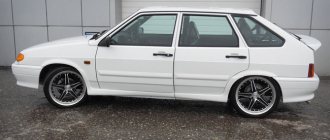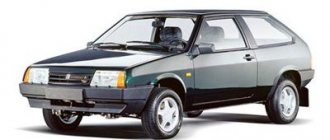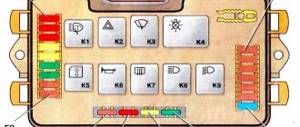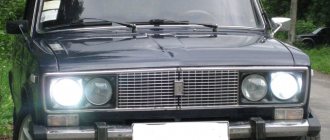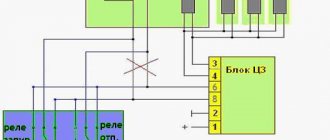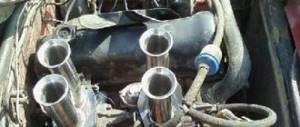The VAZ 2113 belongs to the Samara family and is the direct successor to the outdated VAZ 2108. The compact three-door hatchback became the last representative of the Samara 2. Serial production began in 2004. As in the case of the VAZ 2114, the 13th model received the same rear part, only the bumper changed. The silhouette of the car follows the legendary figure eight, with the exception of a more modern front end.
History of the creation of the VAZ 2113
The car and its modifications appeared in the Volzhsky Automobile Plant model range as a restyled version of the obsolete VAZ-2108 family. By 2005, the level of comfort that cars of the VAZ 2108 family could provide, against the backdrop of an ever-increasing flow of foreign-made cars, ceased to be competitive. In view of this, it was decided to switch to the production of a restyled family of cars while maintaining the same body. This family was supposed to occupy the lowest price niche in the VAZ model line after the final discontinuation of the “classic” models.”
Technical features of the VAZ 2113
The “Thirteenth Model” and its modifications are produced in the same body, but with modified hinged panels, such as the trunk lid, fenders, hood and others.
The interior, compared to the first front-wheel drive family, has changed quite a lot - panels, ceilings, door cards, dashboard and instruments themselves - all of this has been modernized for installation in the new model.
The VAZ 2113 engine was initially installed the same as on the 2108 - an eight-valve transverse engine with a distributed injection system. In 2007, engine capacity increased to 1.6 liters. When equipped with a new engine, the car complies with Euro-3 standards.
In 2010, a limited number of models of the family began to be equipped with a sixteen-valve VAZ-21124 engine with a power of 90 hp from the VAZ 2110 and a forced VAZ-21126 (98 hp) from the LADA Priora. With these engines, the car's rated maximum speed is 185 kilometers per hour.
Characteristics of VAZ 2113
VAZ 2113 is a three-door hatchback.
In fact, 2113 is a modification of the previously produced AvtoVAZ G8 model. Many technical and design solutions are taken from 2114 and 2115 models of the Samara-2 series. “Thirteenth” is extremely popular among Russian youth. In 2007, a 1.6 liter engine began to be installed on the car. with fuel supply, Euro-3 standards, via injection. Before this, the car was equipped with a 1.5 liter engine of Euro-2 environmental class.
Lada 2113 has a completely new design idea regarding the front part of the body. Changes also affected the headlights, fenders and hood. The bumpers began to be painted in body color, and an additional brake light was installed. The adjustable steering column and modified front seat belts are taken from the VAZ 2110.
VAZ 2113 is a well-thought-out, spectacular design, a comfortable, updated interior, equipped with a new dashboard, which makes this model a modernized car, so the population appreciated the release of the VAZ 2113. The design solution allows the car to also transport large-volume cargo.
Modifications of VAZ 2113
Just like in the previous 2108 family, the car is available in three modifications. In addition to the three-door hatchback, the VAZ 2114 model, which replaced the VAZ 21093, is on the assembly line of the Volzhsky Automobile Plant. It differs from the previous model 2114 in the design of the front part of the body with new block headlights, PTF, a modified hood, fenders, radiator grille, other plastic bumpers, moldings and a spoiler , painted in body color.
VAZ 2114
There are also significant differences in the interior design. For example, the VAZ 2114 has a height-adjustable steering column, which was not present in the 2109.
It is noteworthy that 2114 appeared earlier than 2113 - the first car of this model rolled off the Togliatti assembly line in October 2001. Since 2007 (due to stricter standards for the amount of harmful substances in the exhaust), the car has been equipped with a modernized 1.6-liter VAZ-11183 engine that meets Euro-3 requirements. The model receives the VAZ-21144 index.
VAZ 2114
The updated engine is equipped with a new phased injection system to improve efficiency.
Not only the power plant was subject to changes, but also the interior: the car was equipped with a more modern and less noisy dashboard (popularly nicknamed “Europanel”), with an on-board computer, VDO instruments with two liquid crystal displays. The computer shows not only the trip parameters and fuel consumption, but also the outside air temperature, voltage in the on-board network, time, and so on.
Specifications Features
If the body received minor changes, then the engine was seriously modernized. In the first VAZ 2113 models, a power unit from the Lada 2111 was installed - an injection unit with a displacement of 1550 cubic meters. cm. It had a distributed injection system and was practically no different from a carburetor engine; its power was 77 hp. With. Such engines were unpretentious and reliable, but far from perfect. Since 2007, models of the Samara 2 family began to be equipped with a new engine with the index 11183. Its volume is 1.6 liters and the rated power is 82 hp. With. It meets Euro-3 safety standards and regulations. The main distinguishing feature is the presence of a catalyst, which began to be installed in the engine compartment, and not under the bottom. Average fuel consumption ranges from 6.5 to 8 liters per 100 kilometers in the combined cycle.
The VAZ with index 2113 has a fuel tank with a volume of 43 liters. Under the hood you can see a plastic receiver - previously it was aluminum. The latest modification is equipped with an updated 1.6-liter engine. This 16-valve engine produces 89 hp. With. Some changes have been made to the transmission and clutch. Since 2007, an electronic gas pedal has also been installed. In 2010, a limited and last modification of the serial production VAZ 2113 was released. Under the hood, a 16-valve engine from Priora with a rated power of 98 hp was installed. With. The car received a significant increase in dynamic characteristics. The car was produced in various shades, there were about 150 in total. Of these, the most popular were “Quartz” and “Perseus”.
The main idea of creating a compact hatchback is dynamism and good suspension. The braking system is classic, with front disc brakes and drums installed at the rear. The front suspension has a MacPherson strut - independent with wishbones. The rear is semi-independent with a torsion longitudinal beam, springs and shock absorbers. The steering uses a rack and pinion, there is no power assist.
The transmission used is only a manual gearbox, which has no fundamental differences from the gearbox of other VAZ cars of the 10th family.
The car was supplied in three main trim levels: “Standard”, “Norma” and “Lux”. Each of them had its own characteristics. The basic package includes an immobilizer, rear window washer and heating, steering wheel height adjustment, and on-board control. The “Lux” added an athermal windshield, fog lights, powerful sound signals, head restraints for rear passengers, an on-board computer, and side mirrors with anti-reflective coating. Power steering, anti-lock braking system and air conditioning have never been installed on the VAZ 2113.
VAZ 2113 is one of the most convenient cars in terms of tuning and modifications. The main advantages are low cost and inexpensive spare parts. Like the legendary G8, the VAZ 2113 also became a real youth car with a sporty character. The car has already been discontinued, but will remain popular on the secondary market for a long time, so it will not disappear from the roads for many years.
VAZ-2115
A four-door modification that replaced the VAZ 21099. The VAZ-2115 became the first modification in the line of restyled cars of the family. Pilot production of the modified “99th” began back in 1997. The VAZ 2115 is equipped with a new trunk lid, front and rear optics, body-color bumpers, a trunk spoiler, side skirts and a number of innovations in the interior and electrical equipment.
VAZ-2115
The suspension, transmission and braking system are borrowed from models of the 2108 family, although their modernization was initially planned. The angular shapes in the exterior are a thing of the past. By lowering the rear edge of the trunk, loading things has become noticeably more convenient.
Particular attention was paid to improving electrical equipment. The equipment included: power windows for the front doors, PTF, and new headlights. In the luxury version, the car is even equipped with heated front seats. A trip computer that allows you to monitor the condition of the lamps, oil level, brake pad wear, and the level of coolant and washer fluids is included in any package.
VAZ-2115
From 1997 to 2000, the 2114 was equipped with VAZ-21083 carburetor engines with a displacement of 1.5 liters and a power of 71.6 liters. With. Since 2000, with the start of mass production, this power unit was replaced by a VAZ-2111 engine with distributed fuel injection. The volume remained the same, but the power increased to 77.8 liters. With. Since 2008, they stopped installing the VAZ-2111 engine, replacing it with the more advanced VAZ-11183, with a volume of 1.6 liters and a power of 80.9 hp. With.
Production of the VAZ-21099 continued until 2004, and then the old model was discontinued, completely replacing the “fifteenth”.
In 2008, the VAZ-2115 underwent minor changes, affecting mainly the exterior.
Technical characteristics of VAZ-2113
| Body type | hatchback |
| Number of doors | 3 |
| Places | 5 |
| Trunk volume, dm3 | 330/600 |
| Overall dimensions, mm: | |
| length | 4122 |
| width | 1650 |
| height | 1402 |
| own weight, kg | |
| payload, kg | |
| curb weight, kg | 945 |
| total weight, kg | 1370 |
| Wheelbase, mm | 2460 |
| Front wheel track | 1400 |
| Rear wheel track | 1370 |
| Drive wheels | front |
| Ground clearance to floor pan | 170 |
| Clearance to clutch housing | 160 |
| Engine | 2111 |
| working volume, cubic cm | 1499 |
| number of valves | 8 |
| Max power, kW (at rpm) | 57,2 (5400) |
| Max power, hp | 77,8 |
| Max. torque, Nm (at rpm) | 115,7 (3000) |
| supply system | distributor injection |
| immobilizer | + |
| adsorber, neutralizer | — |
| KP | |
| Number of gear stages | 5 |
| Gearbox ratios: | |
| I | 3,636 |
| II | 1,95 |
| III | 1,357 |
| IV | 0,941 |
| V | 0,784 |
| reverse | 3,53 |
| Final drive ratio | 3,7 |
| Maximum speed, km/h | 158 |
| acceleration to 100 km/h, s | 13,2 |
| Fuel consumption, l/100 km: | |
| fuel consumption at 90 km/h | 5,7 |
| fuel consumption at 120 km/h | 7,8 |
| fuel consumption in the urban cycle | 8,9 |
| Fuel tank capacity, l | 43 |
| Front brakes | disk |
| Rear brakes | drums |
| Braking distance of a loaded vehicle from 80 km/h | 38 |
| Parking brake drive | cable |
| Clutch drive | cable |
| Front suspension | McPherson |
| Rear suspension | longitudinal growl |
| Steering | rack and pinion |
| Smallest turning radius | 5,2 |
| Maximum lift without acceleration | 34 |
| Tires | 165/70R13 175/70R13 |
| Steering wheel | 2110 |
| Dashboard | 2114 |
| Instrument cluster | 2115 |
| Rugs | brushed |
| Rear window defroster | + |
| Power windows in front. dv. | + |
| Electric door locks | + |
| Cooling fan | electric |
| On-board control system | + |
| Flight computer | — |
| Bumpers | original |
| Headlight cleaner | — |
| Individual lighting lamp | + |
| Fog lights | + |
| Exterior mirrors | left and right |
| Anti-glare mirrors | — |
| Power mirrors* | — |
| Heated front seats | +** |
| Seat upholstery | tweed with pocket |
| Seat upholstery made from grow. fibers | + |
| Headlining | one-piece molded |
| Door trim | one-piece molded |
| Trunk lining | + |
| Sun visor with mirror | — |
| Rear seat head restraints | + |
| Plastic trunk mat | — |
| Per. seat belts with alarm | — |
| Door moldings | + |
| Side skirt fairings | + |
| Wheel covers | + |
| Trunk spoiler with brake light | + |
| Tinted windows | — |
| Metallic paint | + |
| Noise level in the cabin | |
| at speed 100 km/h, dB/A | 74 |
| Toxicity standards | R 83 |
* - as you master it ** - installed on special equipment
